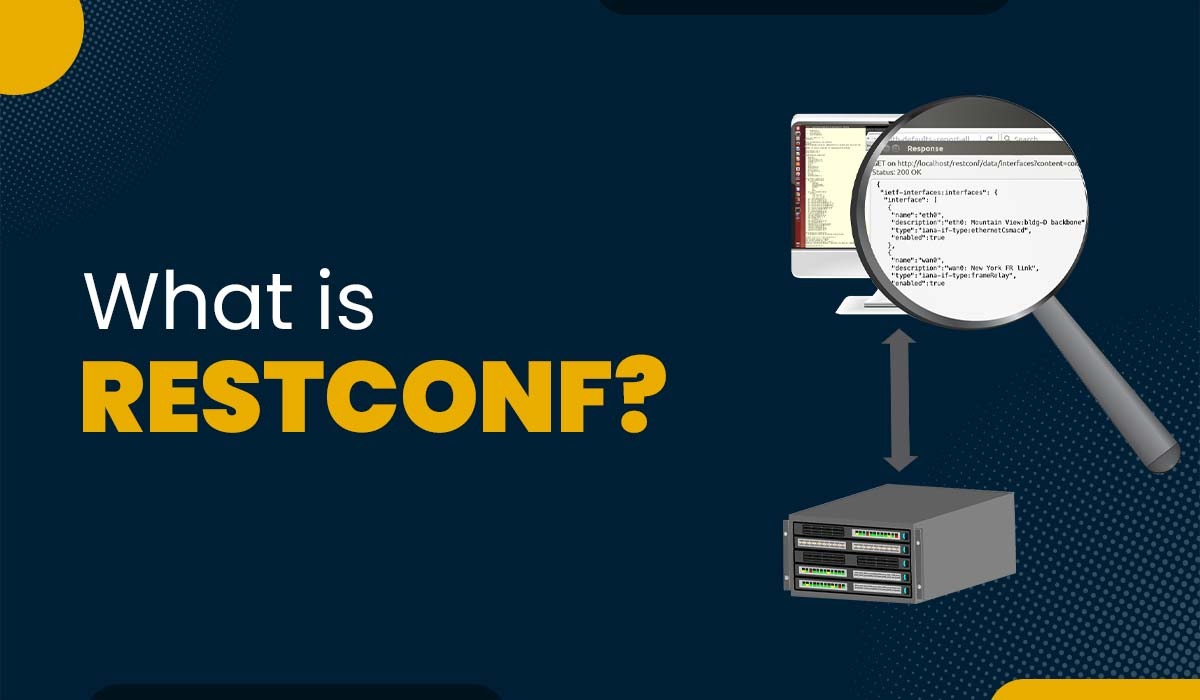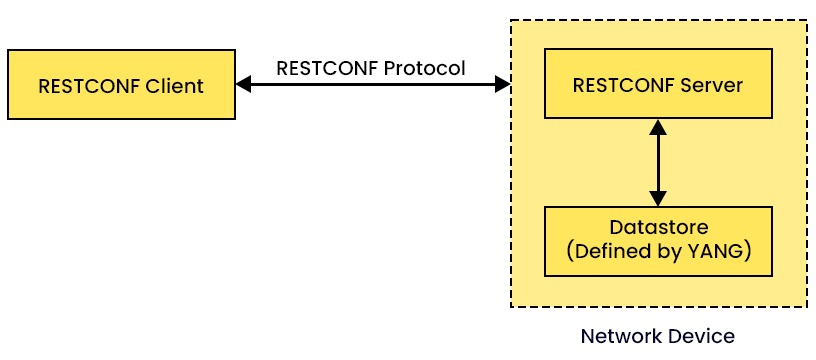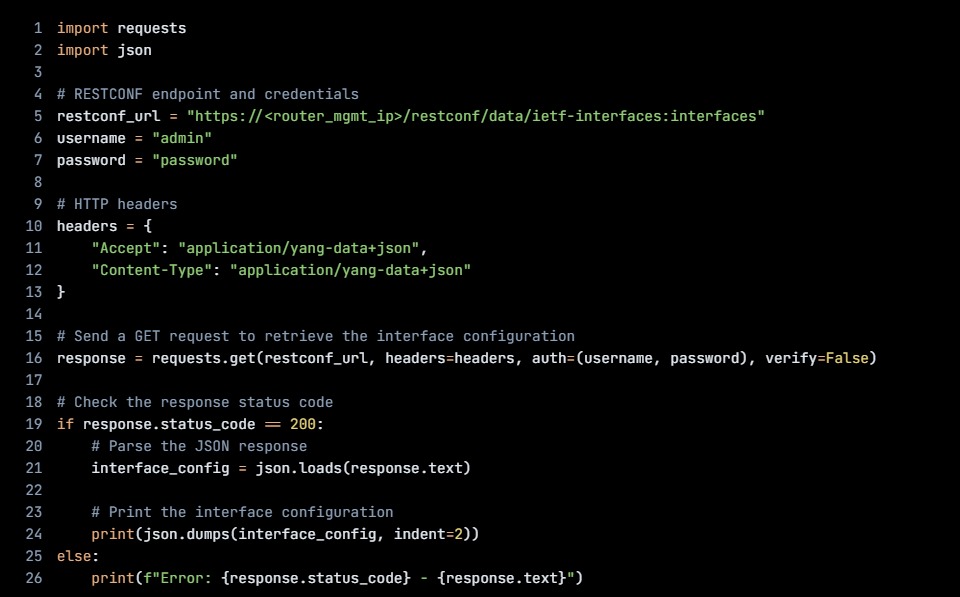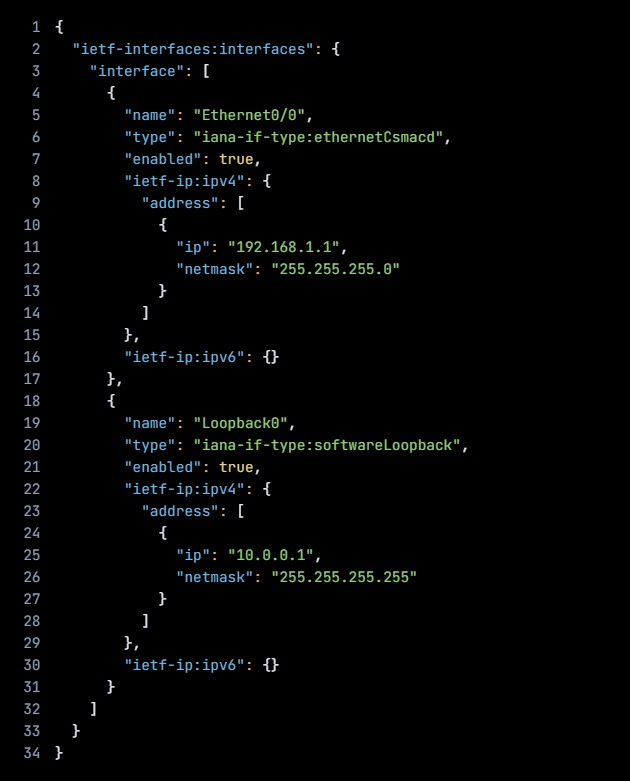What is RESTCONF?

In today’s world, there is a pressing need for consistent protocols in network management and automation. Networks are becoming more intricate. CCIE network professionals, along with many others, struggle with the limitations of old management protocols to keep up with the changes. This is where RESTCONF steps in. It is a standard protocol developed to fix the limits of network management protocols like NETCONF. It provides a better user interface for interacting with network devices. It lets network admins and developers manage and configure network elements. They can do this using a familiar RESTful API. In this blog, you will learn about Cisco RESTCONF, what is it used for? You will also learn its elements along with its pros and cons. Mastering these advanced protocols requires specialized knowledge and hands-on experience. For those seeking to excel in network automation and configuration, Cisco DevNet Expert training offers a comprehensive curriculum. This program equips network professionals with the skills and tools needed to leverage modern automation solutions like this. Let’s first understand what RESTCONF is. RESTCONF is a standard protocol that mainly defines a programmatic interface in order to access as well as manipulate configuration data, operational state data, and event notifications on network devices. It is an evolution of the NETCONF (Network Configuration Protocol), which has been widely used as a network management protocol. It follows the REST (Representational State Transfer) style, which is widely used in web development and has established itself as a standard for constructing scalable and interoperable applications. It also presents an approach to creating, reading, updating, and deleting network device configurations and operational data through HTTP methods (GET, POST, PUT, PATCH, and DELETE). This enables network administrators and developers to interact with network devices in a systematic way. It empowers them to automate tasks related to network management and streamline their workflows. RESTCONF’s versatile nature makes it to be employed in a wide range of network management scenarios. Below, we have discussed some of the use cases. Let’s discuss its different components. There are several RESTCONF components that work together in order to provide a better network management solution. Below, we have discussed these components in detail. It is the entity that initiates requests to the server. This can be a network management application, a custom-built script, or can also be any other software that needs to interact with the networking devices. It defines the communication between the RESTCONF client and the server. It specifies HTTP methods, headers, and media types that are used for various operations as well as the structure and format of the data that has been exchanged. Network Devices include its Server and Datastore. The network device acts as the server that exposes a RESTCONF-based interface in order to manage its configuration and operational state. The server usually interacts with the device’s internal datastore in order to handle the requested operations. Let’s understand its usage in a practical scenario with a Python-based example. In this example, we will make use of the ‘requests’ library in order to interact with a RESTCONF-enabled network device and retrieve the current interface configuration. This script uses the ‘requests’ library to send a GET request to a RESTCONF endpoint and retrieve the interface configuration in JSON format. The script sets the ‘Accept’ and ‘Content-Type’ headers to ‘application/yang-data+json’, and provides the ‘username’ and ‘password’ for authentication. If the request is successful (status code 200), the script parses the JSON response and prints the interface configuration. If the request fails, the script prints the error status code and message. The output of the above example will be: Before getting into the advantages and disadvantages, you need to understand the basic difference between it and NETCONF. Below, we have discussed the basic difference between the two in a tabular form based on different factors. Let’s now discuss its advantages. Some of the advantages of using it are: Here are some of its disadvantages: RESTCONF is a protocol that is mainly used to manage as well as configure network devices and services over RESTful API. It offers a standardized way in order to interact with network infrastructure using HTTP methods and JSON data formats. NETCONF makes use of XML-based messages and the RPC (Remote Procedure Call) model. On the other hand, RESTCONF makes use of RESTful API with HTTP methods and JSON or SML data formats. RESTCONF is a specific protocol in order to manage network devices and services. REST API is a more general term for any web service that works on REST (Representational State Transfer) principles. SNMP, or Simple Network Management Protocol, monitors networking devices. On the other hand, RESTCONF is mainly focused on device configuration and management. RESTCONF is one of the best network management protocols that address the limitations of previous approaches with the use of RESTful APIs and HTTP. It offers a standardized way for network engineers in order to manage monitor, and configure network devices, enabling greater automation, integration, and flexibility in network operations. In this blog, we have discussed it in detail, along with its use cases. We also have explained its use in Python with examples and different advantages as well as disadvantages associated with it.Introduction
What is RESTCONF?
What RESTCONF is used for?
RESTCONF Components

RESTCONF Client
RESTCONF Protocol
Network Devices
RESTCONF in Python


NETCONF vs RESTCONF
Factor NETCONF RESTCONF Protocol Uses XML-based messages over a secure shell (SSH) connection Uses HTTP/HTTPS for communication and JSON or XML for data representation Data Model Relies on YANG data modeling language Can work with various data models, including YANG Operations Provides a set of well-defined operations (e.g., <get>, <edit-config>, <commit>) for managing network devices Leverages the HTTP methods (GET, POST, PUT, DELETE) for performing CRUD (Create, Read, Update, Delete) operations Transactional Nature Supports atomic, consistent, isolated, and durable (ACID) transactions for configuration changes Provides a more lightweight, non-transactional approach to network management Vendor Adoption Widely adopted by network equipment vendors and is a standard for network configuration management Gaining traction, but not as widely adopted as NETCONF across the industry Use Cases Suitable for complex, mission-critical network configurations that require strict transactional guarantees Suitable for simpler, more frequent network management tasks and integration with web-based applications Advantages of RESTCONF
Disadvantages of RESTCONF
Frequently Asked Questions
Q1 – What is RESTCONF used for?
Q2 – What is the difference between NETCONF and RESTCONF?
Q3 – What is the difference between RESTCONF and REST API?
Q4. What is the difference between RESTCONF and SNMP?
Conclusion







